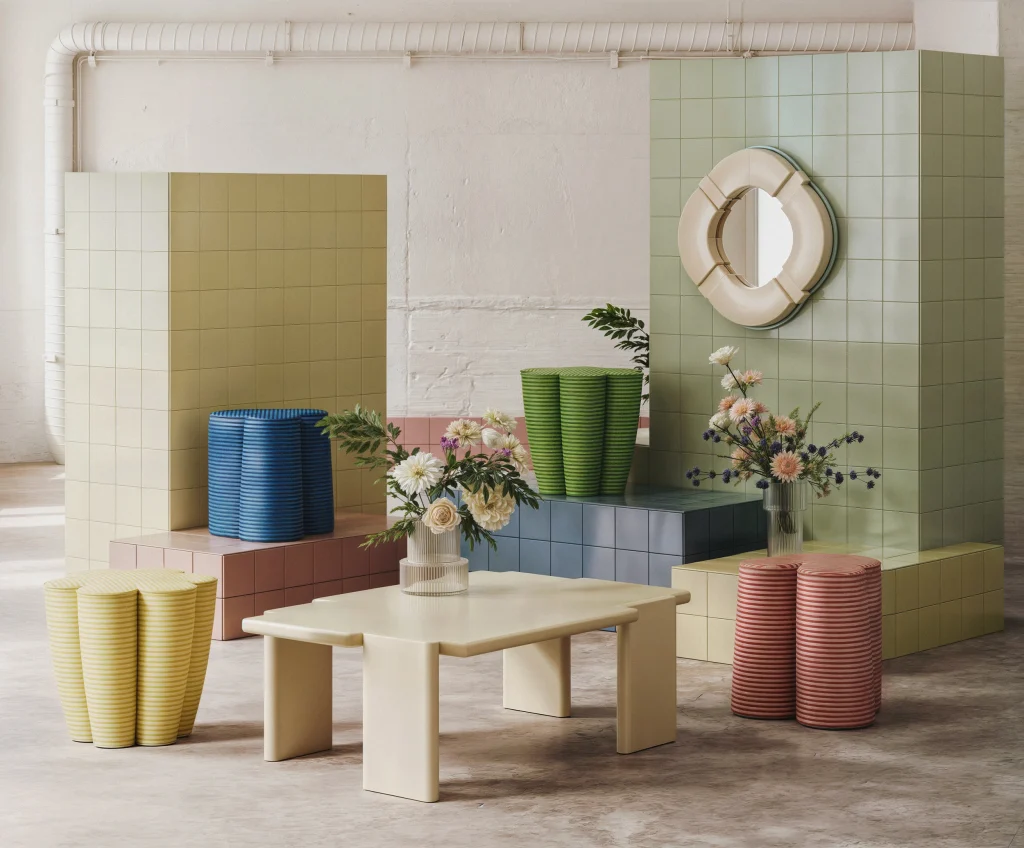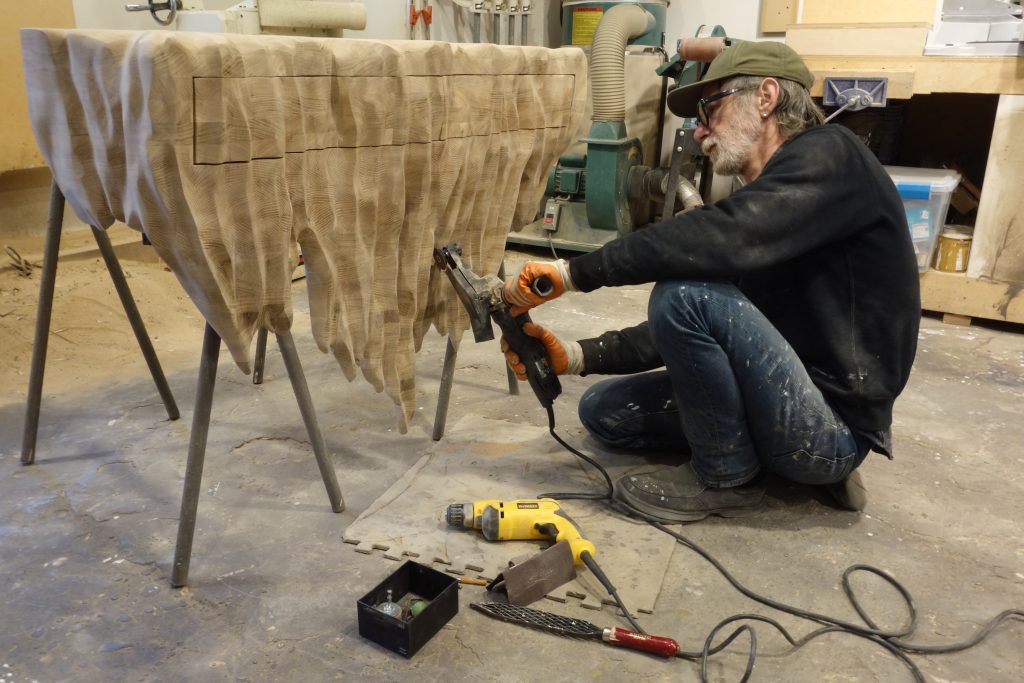
Christian + Jade: Encouraging Valuable Interactions through Intentional Design
“Instead of consistently working within a specific form or function, we seek to communicate the changes that we see in the world and our own behaviours through techniques and materialities that best convey and challenge it.”
– Christian + Jade
View Christian + Jade’s showroom, including “Gathering Heat”
Denmark-based design studio Christian + Jade use their practice to explore our relationship with objects, creating pieces which celebrate the influence of innovative product design on our everyday lives. Functionality and aesthetics go hand in hand to develop pieces which address constantly evolving user behaviours and needs. The duo, who took their education in the Netherlands and currently work in Denmark, has developed their own exploratory design language which merges the interdisciplinary experimentation of the Dutch design scene with the timeless craftsmanship of the Danish design scene. They work between different media, including metal, foam, glass, and porcelain, in a variety of forms and techniques, offering them a vast range of opportunities for research and creation. Their pieces rethink the design in our living spaces, encouraging sensible and valuable interactions with objects that might have previously been overlooked.
Interaction and intention lead Christian + Jade’s approach to design. Whether derived from a client brief or their own desire to solve a challenge, their work embodies a unique, solution-based facet of collectible design. An example of this can be seen in the “Fire Keeper” series, which draws on the age-old relationship which humans have had with the element of fire. As mentioned by Christian + Jade below, the studio addressed their own brief to design pieces for gathering, culminating in this series which elegantly and safely reintroduces fire into the home via the “Reflecting Flame” (I & II) candleholders, “Gathering Heat” fireplace, and “Smoke Cloud Chandelier”. An innate sense of intimacy and warmth is reflected in the forms and materials of these pieces, creating an atmosphere which encourages gathering and human interaction.
As a studio, what do you wish to develop and/or present through your work?
Our studio is founded on an understanding of how our spaces and the objects within it can influence and enrich the ways in which we dwell and live. The pieces that we design are largely inspired by the instinctive search and desire for intimacy and a sense of belonging in the routines and interactions within our physical spaces.
We enjoy creating works that encourage sensible and valuable interactions, through their conceptually driven functions and their earnest materiality. Instead of consistently working within a specific form or function, we seek to communicate the changes that we see in the world and our own behaviours through techniques and materialities that best convey and challenge it.
Coming out of your education in the Netherlands, how would you describe the similarities and differences between the Dutch design scene and the Danish design scene? Where do you see your practice within these two design scenes?
What’s very interesting for us, having been educated in the Netherlands and Christian being from Denmark [and] with both of us now working there, is that we have gotten to get an insight into two countries that [have] design as a highly intrinsic aspect of their national identity, and are prominent for it.
Based on our years at the Design Academy Eindhoven, we would say that the Dutch design scene is founded on experimental and interdisciplinary practices, where the boundaries of what defines design is constantly challenged and in flux, resulting in works and practices that focuses on innovation, speculation, and pushes us to rethink the status quo. Danish design is rooted in a history of elegant, ergonomic, and well-crafted design, with pieces that have become timeless classics of today. The key focus on high quality workmanship and applied, natural, and responsibly-produced material can be seen in Danish design today.
We see influence from our education in the Netherlands on the function and intention of the objects that we design and the message that we want to convey. There is definitely an attraction to techniques, craft, material, and finishing, in creating a sensuous presence in a way that we feel is influenced by Danish design.
“…our inspiration never comes solely from one place – sometimes it is a response to a shift in society [that] we believe design can address. Other times, it is a function or atmosphere that we believe can bring value to our everyday interactions, and, between this, there is the excitement of discovering new materials and techniques that inspires form while materialising our visions.”
Referencing the importance of research in your practice, can you describe your process when developing a new piece?
Most of our works have been developed with a brief or within a context, for an exhibition, residency, or client. As a result, our inspiration never comes solely from one place – sometimes it is a response to a shift in society [that] we believe design can address. Other times, it is a function or atmosphere that we believe can bring value to our everyday interactions, and, between this, there is the excitement of discovering new materials and techniques that inspires form while materialising our visions.
If we have to distill what inspires us to create, it would be to create sensuous, sensible, valuable, and intimate interactions with our physical environment.
One of your projects – “Tableware” – challenges you to explore different crafts and methods of creation. What has this series allowed you to explore so far and discover about your design identity?
The “Tableware” series gives us complete free rein to experiment, create, and play, and the first few works in this series is only a small start. The freedom has allowed us to discover that whatever the method may be, we are drawn to details, finishing, and forms that come together in controlled aesthetic and atmospheric end results.
We often see the works in the “Tableware” series – especially while creating them – as characters. Instead of designing out of a function or story, we create by finding a dialogue between the material, technique, and form and often find ourselves with a sort of creature. It is then [that] we interact with it and learn about its behaviour and characteristics.
How do pieces like “Reflecting Flame” and “Gathering Heat” embody your philosophy of rethinking the living environment?
“Reflecting Flame”, “Gathering Heat”, and “Smoke Cloud Chandelier” are part of the same series. This series came out of a brief we gave ourselves: Design for Gathering. While researching how we can bring people together, we turned to the fire upon discovering that it has played a key role in our collective history as a living form which humans gathered around for warmth, light, and protection. We begin diving into how we could reintroduce the fire back into our modern homes in a safe, sustainable, and beautiful way and, ultimately, bring people together in its unspoken familiar and shared experience.
The fire brings a dimension of life into a space. It is beautiful [and] fascinating, yet dangerous for it is living and very much alive. It requires our attention, our patience, and an understanding of our space and activity. It is far from a careless switch of a light bulb or a change in the meter on a heater. This series embodies how we seek to rethink our living environment as one that can encourage more conscious, valuable, and sensible interaction.
We don’t see objects as inanimate, we believe that they can allow us to form a more intimate relationship with our physical surroundings, enhancing a sense of belonging and well being.
Bio
Christian Hammer Juhl (DK) and Jade Chan (SG) are a design duo educated at the Design Academy Eindhoven, Netherlands and currently based in Copenhagen, Denmark.
Christian + Jade celebrates the influence that our products can have on our lifestyle by designing everyday objects to encourage sensible and valuable interactions. Working out of the intention to rethink our living environment, the duo manifest works that spans between a variety of material and techniques, which comes together in a strong visual language and intent.


















Responses